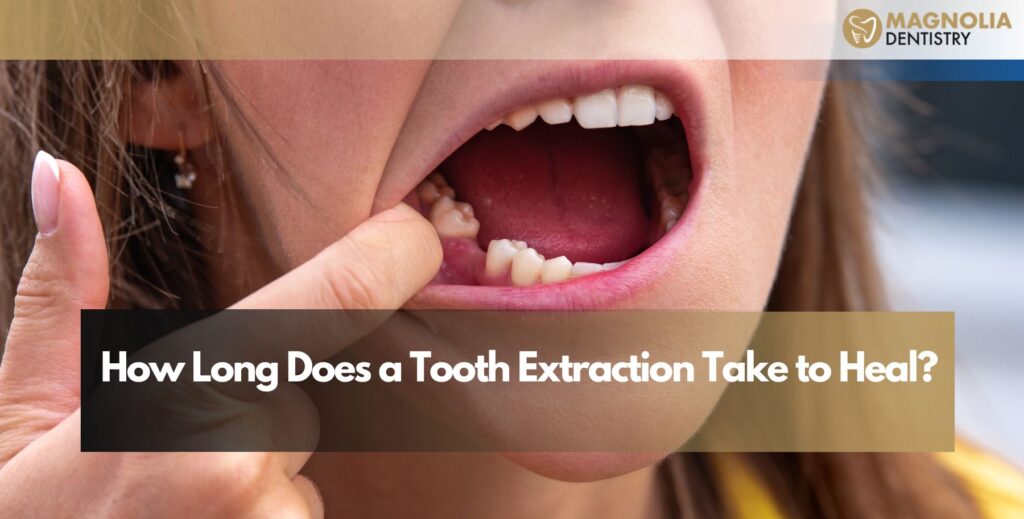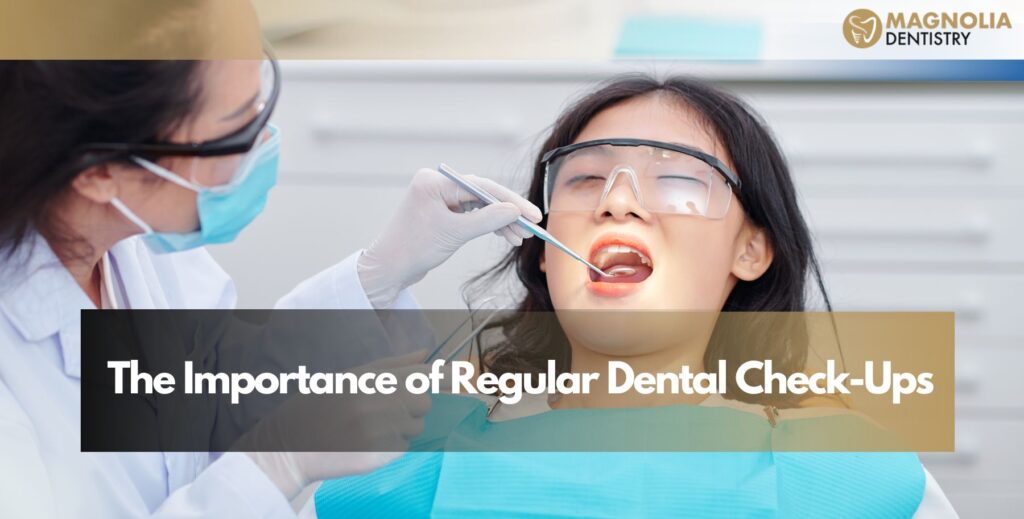Getting a tooth extracted can feel intimidating, but understanding the recovery process can make it much easier. Whether it’s a wisdom tooth removal, damaged tooth, or extraction for orthodontic purposes, healing properly is essential for maintaining good oral health.
At Magnolia Dentistry, our goal is to ensure that every extraction — and the recovery that follows — is smooth, comfortable, and complication-free. In this detailed guide, we’ll explain how long it takes to heal after a tooth extraction, the stages of recovery, what to expect, and how to promote faster healing at home.
What Happens During a Tooth Extraction?
A tooth extraction is a dental procedure where a tooth is removed from its socket in the bone. There are two types of extractions:
Simple Extraction
This is performed when the tooth is visible above the gum line. After numbing the area, your dentist gently loosens and removes the tooth using dental instruments.
Surgical Extraction
This is a more complex procedure used for teeth that are impacted, broken below the gum line, or have not fully erupted (such as wisdom teeth). It involves making a small incision in the gum and possibly removing a portion of bone to extract the tooth safely.
Both types of extractions are performed under local anesthesia, ensuring minimal discomfort during the procedure.
The Typical Healing Timeline After Tooth Extraction
Healing from a tooth extraction happens in stages. Every patient’s recovery time may differ depending on the type of extraction, overall health, and how well aftercare instructions are followed.
Here’s a breakdown of the general healing timeline:
The First 24 Hours – Blood Clot Formation
The first day after your extraction is the most critical. A blood clot forms in the empty socket, serving as a protective layer over the bone and nerves underneath. This clot is vital for healing — if it becomes dislodged, it can lead to a painful condition known as dry socket.
What to Expect:
- Mild bleeding for a few hours after extraction.
- Swelling or tenderness around the area.
- Minor discomfort controlled by prescribed medication or over-the-counter pain relievers.
Aftercare Tips:
- Bite gently on gauze to stop bleeding.
- Avoid spitting, smoking, or using straws for 24 hours to protect the blood clot.
- Stick to soft foods and cold liquids.
Days 2–3 – Initial Healing Phase
During the next two days, swelling and discomfort are at their peak but begin to subside gradually. The soft tissue around the extraction site starts to close up, and your body continues to heal internally.
What to Expect:
- Reduced bleeding.
- Moderate swelling that starts to go down.
- Some stiffness in the jaw or mild bruising around the area.
Aftercare Tips:
- Apply a cold compress in intervals to reduce swelling.
- Continue with soft foods like mashed potatoes, soup, or yogurt.
- Keep your mouth clean using warm salt water rinses (starting after 24 hours).
Days 4–7 – Tissue Regeneration Begins
By the end of the first week, new tissue begins forming in the socket, closing the wound and preventing infection. Most patients start to feel much better at this stage.
What to Expect:
- Swelling and soreness should continue to decrease.
- You may resume normal eating (avoiding crunchy or spicy foods).
- Slight sensitivity around the site is still normal.
Aftercare Tips:
- Maintain good oral hygiene without disturbing the healing site.
- Brush and floss carefully.
- Avoid smoking or alcohol, which can slow down recovery.
Weeks 2–3 – Bone Healing and Full Tissue Recovery
The gum tissue will have mostly healed by this stage, and any residual soreness should disappear. However, internal bone healing continues for several more weeks.
What to Expect:
- Minimal or no pain.
- Gums have closed over the extraction site.
- You can resume normal oral hygiene routines and eating habits.
Aftercare Tips:
- Continue regular brushing and flossing.
- Follow up with your dentist if you had stitches that need removal.
- Attend your post-extraction check-up to ensure proper healing.
1–2 Months – Complete Bone Healing
While the visible gum tissue heals within a few weeks, complete bone healing can take up to 8–12 weeks. This stage is especially important if you’re planning to replace the extracted tooth with a dental implant, bridge, or denture.
Your dentist may recommend waiting until the bone has fully regenerated before placing any restoration.
Factors That Affect Tooth Extraction Healing Time
Not everyone heals at the same pace. Several factors can influence your recovery timeline:
Type of Extraction
Surgical extractions (especially for impacted teeth) take longer to heal than simple ones because of deeper incisions and bone involvement.
Age and General Health
Younger, healthy patients tend to heal faster. Conditions such as diabetes or autoimmune disorders can slow recovery.
Smoking and Alcohol Use
Nicotine and alcohol can interfere with blood flow and delay tissue healing, increasing the risk of infection.
Oral Hygiene Practices
Keeping the extraction site clean and free from debris helps prevent complications and promotes faster recovery.
Following Post-Operative Instructions
Patients who carefully follow aftercare instructions — including rest, soft diets, and proper hygiene — typically experience quicker healing.
How to Speed Up Healing After Tooth Extraction
Proper aftercare can make a big difference in how quickly and comfortably you recover.
Follow Your Dentist’s Instructions
Always adhere to prescribed medications, dietary recommendations, and oral care guidelines provided by your dentist.
Manage Swelling and Pain
Apply ice packs intermittently for the first 24 hours to reduce swelling. Over-the-counter pain relief can help manage discomfort.
Stick to Soft Foods
Eat soft, easy-to-chew foods like oatmeal, smoothies, and scrambled eggs. Avoid hot, crunchy, or spicy items.
Avoid Dislodging the Blood Clot
Do not rinse vigorously, spit forcefully, or use a straw for at least 24 hours after extraction.
Stay Hydrated and Rest
Drink plenty of water and get adequate rest to help your body heal efficiently.
Avoid Smoking
Smoking can dry out the mouth, reduce oxygen supply, and significantly increase the risk of dry socket.
When to Call Your Dentist
While mild discomfort is normal during recovery, certain symptoms may indicate a complication that needs professional attention:
- Severe or persistent pain after 3–4 days
- Excessive bleeding or pus discharge
- Foul odor or taste in the mouth
- Swelling that worsens instead of improving
- Fever or chills
If you experience any of these signs, contact your dentist immediately for evaluation and care.
Long-Term Healing and Tooth Replacement
After full recovery, your dentist may recommend replacing the missing tooth to prevent shifting and bone loss. Common replacement options include:
Dental Implants
A permanent solution that replaces the tooth root and provides a natural look and feel.
Dental Bridges
Ideal for patients missing one or more teeth in a row.
Partial Dentures
A removable and cost-effective way to restore function and aesthetics.
Your dentist will guide you on the best replacement based on your oral health and goals.
Conclusion
So, how long does a tooth extraction take to heal? For most patients, initial healing takes 7–10 days, while full bone recovery may take 8–12 weeks. The exact timeline varies depending on your overall health, type of extraction, and how closely you follow post-procedure care instructions.
At Magnolia Dentistry, we ensure every extraction is performed with precision, comfort, and care. Our team provides detailed aftercare guidance to help you recover quickly and safely. Whether it’s a simple or surgical extraction, your comfort and long-term oral health are always our top priority.
FAQs
How long should I rest after tooth extraction?
Rest for at least 24 hours after your procedure. Avoid strenuous activity for the first 48 hours to prevent dislodging the blood clot.
When can I brush my teeth after extraction?
You can brush gently after 24 hours, avoiding the extraction site for the first few days.
How long does the pain last after extraction?
Mild discomfort may last for 2–3 days, gradually subsiding within a week.
Can I eat solid food after tooth extraction?
Stick to soft foods for the first 3–5 days. Gradually reintroduce solid foods once the area feels comfortable.
What should I do if my blood clot falls out?
If the clot dislodges, you may develop dry socket. Contact your dentist immediately for treatment and pain management.
How long before I can get a dental implant after extraction?
Typically, dental implants can be placed 2–3 months after extraction, once the bone and gums have fully healed.



